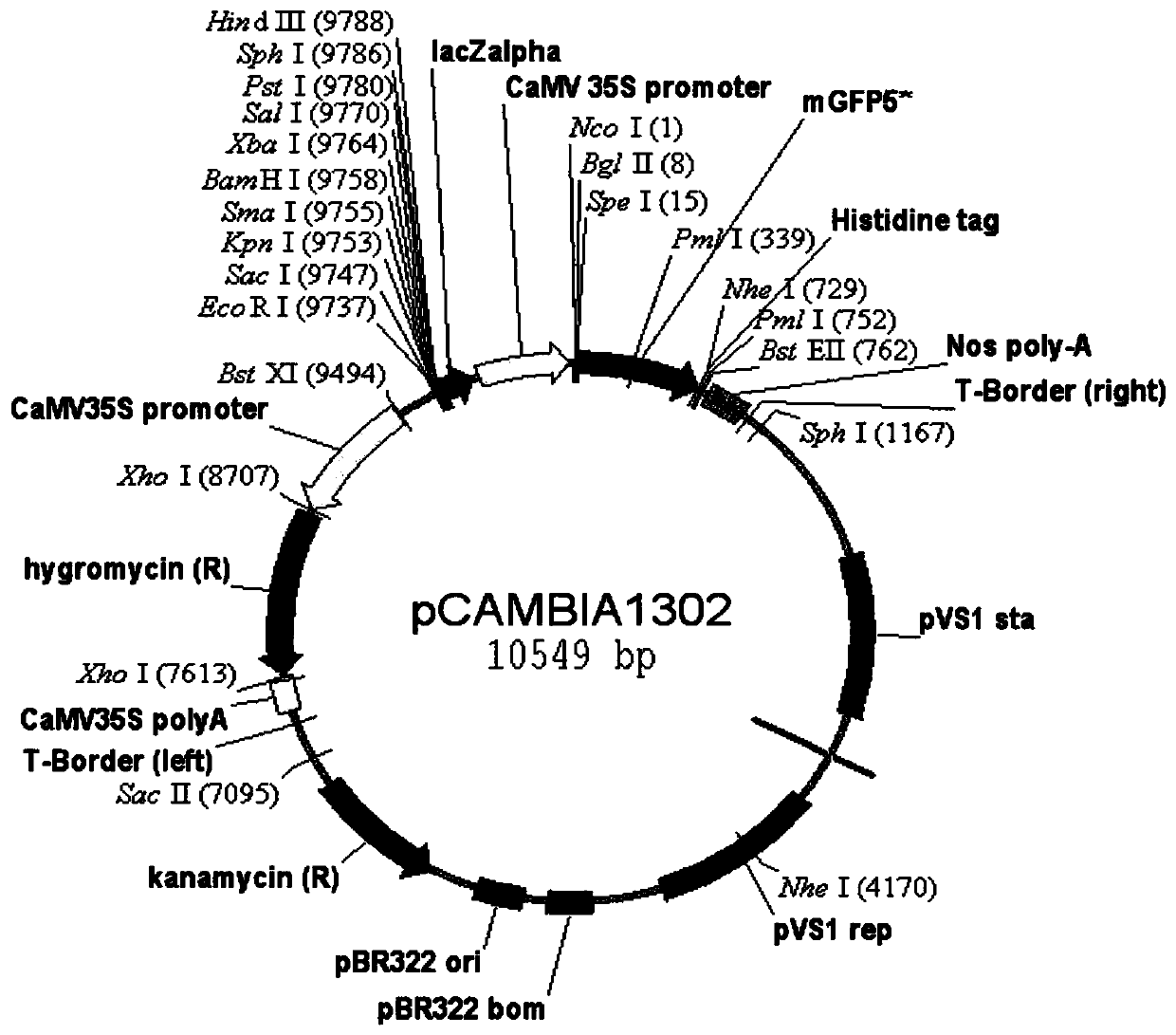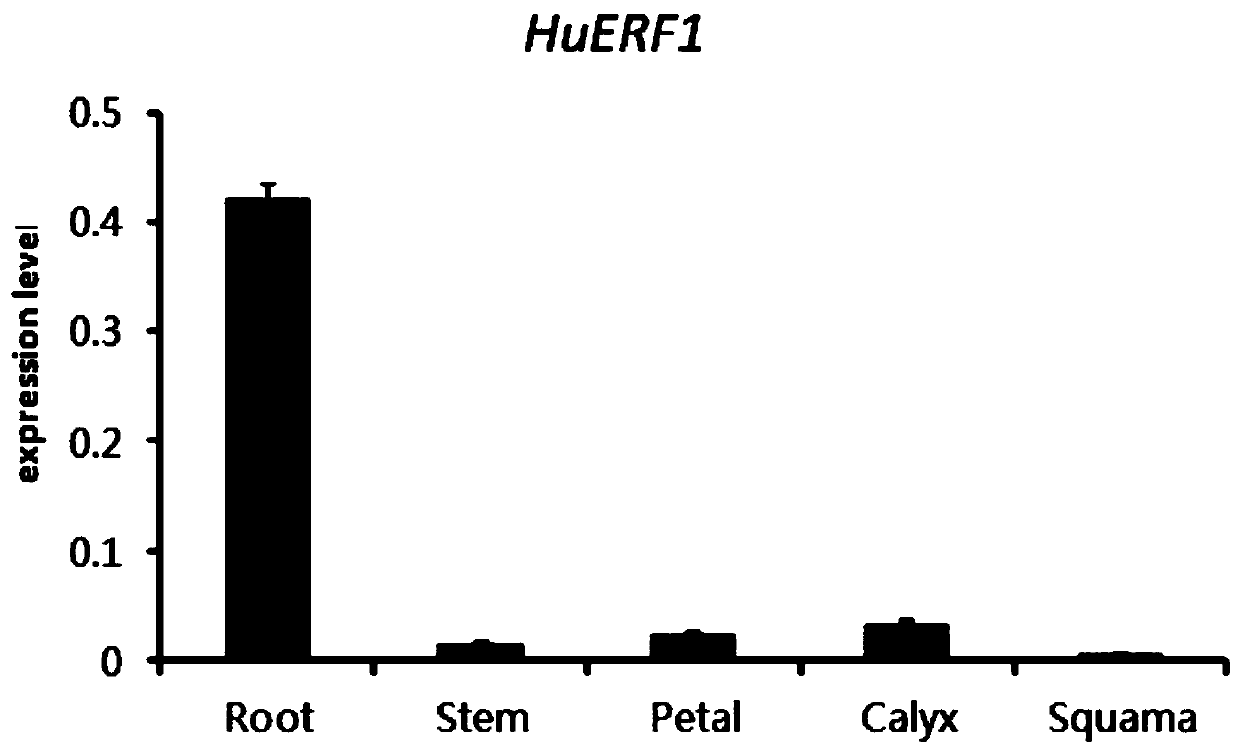Hylocereus spp. salt-tolerant gene HuERF1 and application thereof
A technology of dragon fruit and gene, which can be applied in application, genetic engineering, plant genetic improvement and other directions, and can solve problems such as difficulty in exerting yield potential.
- Summary
- Abstract
- Description
- Claims
- Application Information
AI Technical Summary
Problems solved by technology
Method used
Image
Examples
Embodiment 1
[0050] Construction and genetic transformation of the Over-expression overexpression vector of embodiment 1.HuERF1 gene
[0051] The overexpression vector used in the present invention is pCAMBIA1302-ERF1 constructed in our laboratory. The construction steps of the vector are as follows: extract the total RNA in the dragon fruit seedlings, reverse transcribe into cDNA, use the cDNA as a template, and use the upstream primer: 5'-TGACCATGGTAGATCTGATGTGTGGCGGTGCAATCTT-3' (SEQ ID No.4) and the downstream primer 5' - CTTCTCCTTTACTAGTAGCAGCAGAAGAAGGAACATC-3' (SEQ ID No. 5), a nucleotide fragment (SEQ ID No. 3) with a length of 894 bp was amplified.
[0052] The fragment was connected to the linearized pCAMBIA-1302 vector by infusion method (see figure 1 - on the map of pCAMBIA1302). Reaction system: linearized vector pCAMBIA13020.5μl, PCR fragment 2μl, enzyme 0.5μl, H 2 O 2μl, total volume 5μl, incubate at 50°C for 30min, then at 4°C for 5min. Transform 2 μl of the ligation prod...
Embodiment 2
[0055] Embodiment 2. Adopt 100mM NaCl to observe the influence on Arabidopsis seed germination
[0056] We transformed the clone pCAMBIA302-ERF1 into Agrobacterium EHA105, and soaked wild-type Arabidopsis inflorescences by inflorescence soaking method to obtain T0 generation seeds. Screening of positive transgenic plants was carried out in MS medium with kan antibiotics. The experimental method is as follows: wash the seeds once with 70% ethanol, and then disinfect them with 1% sodium hypochlorite + 0.01% Triton X-100 for 10 minutes; wash the seeds with sterilized distilled water for 3–5 times; spread the washed seeds on MS or MS +Kan solid medium plate, place the plate in a refrigerator at 4°C for 3 days; place the plate in the growth room of Arabidopsis thaliana to continue to cultivate; when the Arabidopsis grows to the size of 2 cotyledons on the plate, transplant it into the nutrient soil . After growing into seedlings, use PCR to identify (such as Figure 4 As shown, ...
Embodiment 3
[0058] Example 3. Treatment of Arabidopsis seedlings with 200mM NaCl at the seedling stage
[0059] After the normal seeds germinated, they were normally planted in the culture medium, and after growing for two weeks at 26°C in 12h light / 12h dark, they continued to treat Arabidopsis thaliana with 200mM NaCl. It was found that many of the wild-type plants were withered, yellow, flowered, and short, while those overexpressing HuERF1 Transgenic Arabidopsis grew significantly better than the control (eg Image 6 As shown, WT: represents wild-type plants; OE: HuERF1 overexpression plants). The above results indicated that overexpression of HuERF1 could improve plant tolerance to salt.
[0060] 1. The successful cloning of the HuERF1 gene in the present invention further proves that the plant ethylene response factor ERF is a key protein in response to salt stress, which is of great significance for a comprehensive understanding of the biological function of the ethylene response f...
PUM
 Login to View More
Login to View More Abstract
Description
Claims
Application Information
 Login to View More
Login to View More - R&D
- Intellectual Property
- Life Sciences
- Materials
- Tech Scout
- Unparalleled Data Quality
- Higher Quality Content
- 60% Fewer Hallucinations
Browse by: Latest US Patents, China's latest patents, Technical Efficacy Thesaurus, Application Domain, Technology Topic, Popular Technical Reports.
© 2025 PatSnap. All rights reserved.Legal|Privacy policy|Modern Slavery Act Transparency Statement|Sitemap|About US| Contact US: help@patsnap.com



